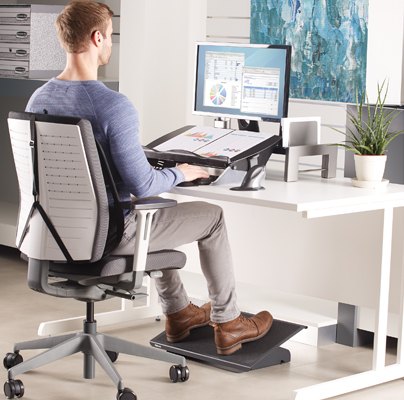Top-to-Toe Ergonomics
Irrespective of the industry we operate in, and the size of organisation we work in, good ergonomics should be part of everyday office design. By taking a holistic approach to the equipment and furniture used, we can dramatically improve the quality of day-to-day working lives and the level of productivity. There are some common physical problems office workers encounter and they all directly relate to their working environment. We’ve set out how, by improving ergonomics in the workplace, we could solve these issues for a happier office and a healthy ROI.


The problem: Low mood and trouble concentrating because of physical pain.
Even low-level pain, if constant, can be distracting and demoralising.
How to help:
You could help by carrying out a full audit of your office ergonomics. Comprehensive workplace assessments could highlight where potential problems are brewing and stop them in their tracks before they impact productivity.
The problem: Eyestrain and neck ache.
The glare from a computer screen or even just a badly lit office space can cause agonising eyestrain, headaches and even migraine. The neck and shoulders can become strained and painful if a monitor is set at the wrong height, causing computer workers to repeatedly shift their gaze up and down if reading or referencing materials on the desk.
How to help:
Make sure lighting is adequate and provide anti-glare filters for monitors, if appropriate. The right monitor, monitor arm or laptopsupport can help office workers achieve the correct ergonomic position, setting the screen at eye level to stop neck strain. Meanwhile, a document holder can help them to avoid constantly moving the head from paper to screen.
The problem: Wrist pain and strain caused by repetitive actions.
Carpal tunnel syndrome, where a nerve is pinched, is one of the most common issues caused by office working. Tendonitis is also common in the wrist, while ‘trigger finger’ is often related to repetitive strain injuries.
How to help:
Wrist Supports can help avoid angling wrists upwards while working, an action that is likely to cause repetitive strain injuries. Wrist supports can be used with keyboards and/or mouse mats to offer a complete ergonomic desk set up. Ergonomic mice can help position the wrist in a more natural and comfortable position.
The problem: Backache.
Anyone who has suffered even the mildest backache will know how impossible it is to work well with this sort of pain. Spending too long in one position, twisting in an unnatural way to reach for the keyboard or phone, hunching over a desk and even crossed legs - all these can put unnecessary pressure on spinal discs and muscles.
How to help:
Provide lumbar support products and attach to existing office chairs, or invest in sit-stand wrokstations, which might be a good choice for some or all office workers. As well as helping workers stay limber, stretching their muscles and adding movement to each day, sit-stand desks have also been shown to have beneficial effects on the waistline.
The problem: Lower back pain.
Incorrectly positioned feet causing pressure and pain in the lower back. The wrong footwear, crossed legs and legs twisted at an angle to the body can all exacerbate back problems.
How to help:
There’s a great range of foot rests to help improve circulation and reduce fatigue by elevating and supporting the feet and lower legs. In turn, this will improve overall posture and help your team members to avoid back pain.
Investing in the right equipment in your office can have huge health benefits for your team. Ask your team to complete a workplace assessment today and find out exactly what kind of physical support they need.




